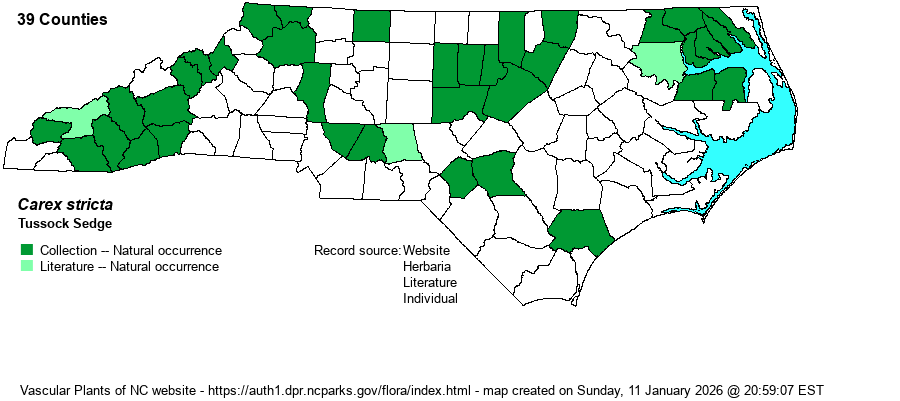| Author | Lamarck | |
| Distribution | Mostly the Mountains, northern half of the Piedmont, and northeastern Coastal Plain; scattered in the Sandhills and in Pender County.
N.S. to Man., south to SC, TN, and KS; disjunct in MS and TX. | |
| Abundance | Ucommon in the Mountains, northeastern Piedmont, and northeastern Coastal Plain; rare elsewhere. Where found, however, plants can be dominant. The editors suggest a State Rank of S3. | |
| Habitat | Montane seepages, bogs, sedge meadows, beaver ponds and their backup swamps, blackwater streamheads in the Sandhills. |
| Phenology | Flowering and fruiting May-June. | |
| Identification | As its name suggests, it forms large tussocks of densely leafy plants; the slender leaves spread outwards and downwards. Flowering stems stand essentially erect, up to 2.5 feet tall, with 2-3 slender female spikes and 3-4 slender male spikes. Up North, one can walk upon old plants (decades old or more!), but it is not steady going. The phrase "like walking on bowling balls" often refers to this species! | |
| Taxonomic Comments | None
The genus Carex is the largest in North America, and among the largest in the world. In temperate and boreal regions, Carex is often the dominant or co-dominant ground layer in many habitats. Seeds (achenes) are valuable food for birds and small mammals, while foliage is used by birds and mammals to make nests and as food by mammals. Species of Carex often look vastly different from one another -- spikes erect vs. drooping, tiny inflorescence vs. whopping, culms leafy vs. naked, perigynia beaked vs. beakless, stems densely bunched vs. single, etc. The genus has been divided into many sections (or groups), based on shared characters; some taxonomists have suggested that these be different genera, but that proves unworkable (so far). All Carex share the feature of a perigynium (an outer covering) which completely surrounds the achene (seed). This covering may fit tightly or loosely (like a small bladder), depending on which group or species. Details of perigynia shape, ornamentation, presence and size of beak, number of striations (or veins) are all important ID features. In recent years Rob Naczi and colleagues have stressed the importance of arrangement of perigynia -- whether spiral (3+ ranks) or distichous (2-ranked) -- and have named a number of new species as well as split off some older synonyms. Therefore, RAB's (1968) key, excellent for its time, can only be used in a general way today. Members of some sections of Carex are difficult to key out (notably Ovales, Laxiflorae, Griseae); this is in part due to variation among individuals of a species, or failings of the key. FNA has drawings of most species and some species may be found in two or more places within a key, to acount for variability. New species to NC, and new to science(!), continue to be found in NC. | |
| Other Common Name(s) | Upright Sedge | |
| State Rank | S3? [S3] | |
| Global Rank | G5 | |
| State Status | | |
| US Status | | |
| USACE-agcp | OBL link |
| USACE-emp | OBL link |

